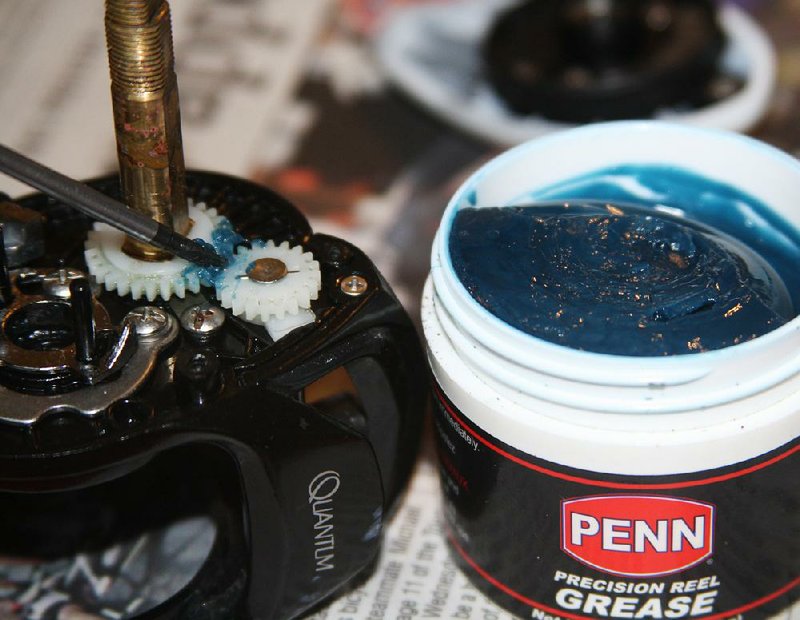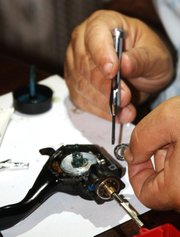When is the last time you cleaned your fishing reels?
I don't mean wiped them down and dropped a bead of oil on the worm gear. I mean took it apart, removed all the old grease, oil and dirt, and refreshed the grease and oil.
Never?
That's why your reels don't turn as smooth as they used to, and why they squeal and growl when you cast and retrieve.
Like all mechanical equipment, fishing reels require regular maintenance to keep the running right. It ensures functionality when you need it most, and it will prolong your reels' lifespans indefinitely.
Now is a good time to do it, as the heat of a summer afternoon makes it unpleasant to fish.
The mere thought of dismantling a fishing reel used to intimidate me. There are too many small parts to keep track of, and it's easy to reassemble them incorrectly.
Economy and curiosity overrode my fears, and now I enjoy it.
My latest projects were a Shakespeare spinning reel and a Quantum Octane 100 baitcaster that my children recently took on a trip to the Gulf of Mexico.
Even though they washed the reels down with fresh water every evening, that only removed sand and salt from the surface. It did nothing for the salt and sand that creeps into the works from normal operation. No matter how careful you are, you will immerse a reel in saltwater. It can happen by dipping it in the water in a moment of inattention, but it will surely happen when waves slam against you.
Naturally, they waited a couple of weeks to inform me of trouble. Both reels were locked up. I dislodged the baitcaster by force, but the spinning reel wouldn't budge. I wasn't surprised because spinning reels, with their stacks of bearings, are more vulnerable to salt corrosion.
I was tempted to pitch them both. They are cheap combo package reels, but salvaging them beats replacing them.
The Quantum Octane is a low-profile baitcaster that's identical to Quantum's Tenacity and similar entry-level models. It's also similar to some inexpensive Abu Garcia low-profile reels.
When I dismantled it, I was curious how this reel got its disposable reputation. Yes, the Octane is made in China, but I saw stainless steel hardware and springs, well-machined brass gears, a shielded main bearing and a beefy roller bearing for the anti-reverse mechanism. The drag was a thick Rulon pad. I did not see low quality.
Regardless of brand, disassembling a baitcaster occurs in several uniform steps.
First, you'll need a small flathead screwdriver, a small Phillips screwdriver, a 1/4-inch drive ratchet and a 10mm socket.
You'll also need a surface to place your parts, like a newspaper, paper towels or a white towel. Place them in any order that makes sense to you. I separate parts by component. The handle parts go in one line, in order of their removal. The drive assembly goes in another line, and the spool assembly goes in another line.
First, unscrew the cap on the handle. It covers a brass nut that secures the handle to the main axle. Remove the cap and place it and its screw together on the towel. The main axle is reverse threaded, so turn the nut clockwise to remove it. Then remove the handle, followed by the flat spring or tension bushing. Place them together, as well.
Remove the star drag assembly by turning it clockwise. There are a number of washers and bushings beneath the star knob. Keep them together in the order of their removal. Remove the spool tensioner knob if necessary.
Remove the four small screws that hold the sideplate to the frame. Gently pry the sideplate free with a flathead screwdriver and remove the sideplate to expose the clockwork.
On the main axle are, from top to bottom, a shielded main bearing that sits atop the anti-reverse roller bearing, which fits over a stainless steel bushing, which sits on a stainless steel washer. Place them in order, and remember which side of the roller bearing faces up.
The opposite sideplate contains the spool brake mechanism. The manner in which it separates from the frame depends brand. The sideplate for the Quantum Octane comes off with a slight downward twist. Pulling out the spool releases the spool drive gear in the clockwork, which allows you to remove the gear and the main drive.
The worm gear was clean, so I left it in place.
With cotton swabs soaked in alcohol, mop out all the old grease and oil from the frame and the linkages. Even though it might look clean, you can run a fingertip across the parts and pick up all kinds of grit. Grit and clockwork are mortal enemies.
I sprayed the brass gears with gun solvent and scrubbed them shiny with a toothbrush.
Everything was in pretty good shape except the main bearing and roller bearing. The actual bearings were undamaged, but the inner diameter of the bearing was rusted. I removed as much as possible with the toothbrush and gun cleaner, and then scrubbed off the rest with 000 steel wool.
I did likewise to the corroded metal parts of the roller bearing. and also to the main axle.
I applied Penn reel grease to the brass gears and installed them. I also greased the white plastic gears.
I applied two drops of oil to the main bearing and roller bearing, and also a drop on the spool bearing. I also applied light drops of oil to all linkage joints.
It went together easily, thankfully with no parts left uninstalled. It's smoother and quieter than when it was new.
The spinning reel is up and running, too, but it was a more complicated project. Evidently it spent more time underwater because its bearings were rusted and inert. Due to a previous encounter of this nature, I keep a varied and versatile supply of bearings on hand. They are Boca Bearings, and they are better than the factory originals.
Sports on 07/16/2017

